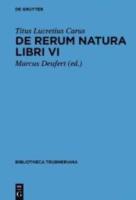
De Gruyter (Bibliotheca Teubneriana) (2019) h/b 314pp £70.72 (ISBN 9783110263513)
D. has been working on Lucretius for 20 years or more, and this Teubner text has been preceded by a volume of Prolegomena (2017) and a Kritische Kommentar (2018). The text, as presented by the MSS, is one which provides—by contrast with Virgil—many difficulties for an editor, the opposition to Lucretius on the part of the Church Fathers on obvious doctrinal grounds being only one of them: as D. observes, studia Lucretiana, quae floruerunt saeculo nono, decumo extenuari coepere, paulo post evanuere, ineunte autem quinto decimo renata sunt (with the arrival of Poggio). D.’s long Praefatio, written in elegant and flowing Latin, even allowing an occasional witticism (‘nam Davus sum non Oedipus’ he quotes from Terence’s Andria at one point), covers in separate sections the major MSS; the Italian MSS, certain printed editions, the apparatus criticus, the ‘subscriptiones et tituli Lucretiani’, matters of orthography, and the fragments. D. then lists the ‘editiones et commentationes quae in apparatibus laudantur’; a notable omission is Cyril Bailey’s Oxford Classical Text of 1921 (second edition), though his editio maior of 1947 is listed: as, indeed, are no fewer than 18 contributions from David Butterfield, who is himself now preparing a new Oxford Classical Text. (Other UK scholars listed naturally include Bentley, Munro, W.M. Lindsay, Housman and M.D. Reeve).
One of the major problems which face an editor of Lucretius concerns interpolation. D. initially proposed the deletion of over 360 lines, reduced for the Teubner edition to 220 lines. Here he stands opposed to Butterfield, who has written, in effect, that if Lucretius did not finish the poem, and could let himself ‘nod in composition’, was the poem then augmented by an over-active reader or an over-zealous editor? —which is not to dispute that many lines are of dubious authenticity. On another important matter, however, D. agrees with Butterfield and Reeve (against Enrico Flores) that the ‘tradition is unitary’—i.e. that the codices antiquiores of the ninth century, the lost codex Poggianus, and the 15th century Itali, all derive from a single archetype. This has the important corollary that the Itali are reduced to the status of transmitters of (numerous) conjectures.
D.’s apparatus criticus—or rather apparatus critici, for there are three, including one which gives repeated lines—is both deep and dense (users should ideally acquaint themselves with section IV of the Praefatio). Take Book 2, line 422: the MSS give us omnis enim sensus quae mulcet cumque videntur. D. asterisks the last word, as being copied from 421. He notes that Schneidewin and Lachmann (and Munro, and, later, Bailey), read figura, to animate the sense. D.’s apparatus also lists iuvans res (Sier), an implausible reading from Avancius (1502) —while omitting an equally implausible reading from the (also Aldine) Juntine,—tibi res (Postgate) and hominum res (Butterfield); that does not exhaust the list of candidates, and it is of course a pity that D.’s apparatus cannot expand on Butterfield’s reasoning: though he gives the full reference on p.xxxix.
Such difficulties haunt the text. At 3.917 the MSS read quod sitis exurat miseros atque arida torrat, the last word—a 3rd conjugation by-form (Bailey) —being asterisked by D., whose apparatus puts forward conjectures by Mueller, Lachmann, Romanes, Housman and Butterfield (ac torreat arens). Housman’s conjecture aridu’ torror (printed here without the necessary ecthlipsis of ‘s’) admittedly depends on the certain restoration of torror at a line in Ennius; but more to the point is that D. may not have spotted Housman’s brilliant torrens, in the same article, for MSS tellens at 6.237, where Lambinus’s pollens, accepted by D., has held the day.
However, nobody will be surprised that the name Lachmann appears so frequently in the apparatus, though D. nowhere (so far as I can see) discusses his immense contribution to the construction and elucidation of the text; for that, the Introduction to Munro’s Edition (1864), pp. 20-29, remains worthwhile, and D.’s own Kritische Kommentar may be assumed to have filled the gap. It is clear that the text offered here should ideally be accompanied both by that and by his Prolegomena; indeed, the text offers us the completed building, but the essential ‘scaffolding’ will become apparent only with the accompanying works. It may be helpful to note that a full review of the Prolegomena, by Nicoletta Bruno of the Thesaurus Linguae Latinae, is available on BCMR, dated 17 May 2019.
As always with De Gruyter, the quality of production is very high; I noted only one (untroublesome) typo, on p. 297. Anglophone scholars (including this reviewer) will keenly await David Butterfield’s OCT edition: not least because Cyril Bailey’s editio maior of 1947, competent as it was, yet somehow failed to meet its high expectations (not that he lacked courage—at one point he lists Lachmann’s five reasons for obelizing a line, and roundly dismisses them). It remains only to add that this new text of the De Rerum Natura, by a scholar of distinction, will deservedly receive a warm welcome from Lucretians worldwide.
Colin Leach
